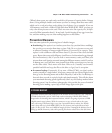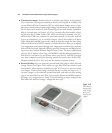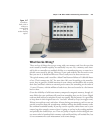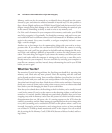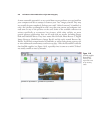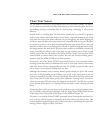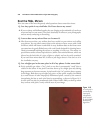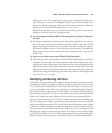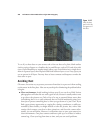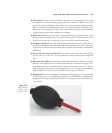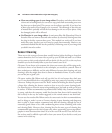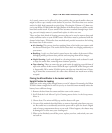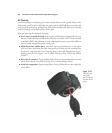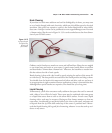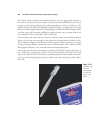Finding one or two hot or stuck pixels in your sensor is unfortunately fairly com-
mon. They can be “removed” by telling the D7000 to ignore them through a sim-
ple process called pixel mapping. If the bad pixels become bothersome, Nikon can
remap your sensor’s pixels with a quick trip to a service center.
Bad pixels can also show up on your camera’s color LCD panel, but, unless they are
abundant, the wisest course is to just ignore them.
Q. I see an irregular out-of-focus blob in the same place in my photos. Is that sen-
sor dust?
A. Yes. Sensor contaminants can take the form of tiny spots, larger blobs, or even curvy
lines if they are caused by minuscule fibers that have settled on the sensor. They’ll
appear out of focus because they aren’t actually on the sensor surface but, rather, a
fraction of a millimeter above it on the filter that covers the sensor. The smaller the
f/stop used, the more in-focus the dust becomes. At large apertures, it may not be
visible at all.
Q. I never see any dust on my sensor. What’s all the fuss about?
A. Those who never have dust problems with their Nikon D7000 fall into one of four
categories: those for whom the camera’s automatic dust removal features are work-
ing well; those who seldom change their lenses and have clean working habits that
minimize the amount of dust that invades their cameras in the first place; those who
simply don’t notice the dust (often because they don’t shoot many macro photos or
other pictures using the small f/stops that makes dust evident in their images); and
those who are very, very lucky.
Identifying and Dealing with Dust
Sensor dust is less of a problem than it might be because it shows up only under certain
circumstances. Indeed, you might have dust on your sensor right now and not be aware
of it. The dust doesn’t actually settle on the sensor itself, but, rather, on a protective fil-
ter a very tiny distance above the sensor, subjecting it to the phenomenon of depth-of-
focus. Depth-of-focus is the distance the focal plane can be moved and still render an
object in sharp focus. At f/2.8 to f/5.6 or even smaller, sensor dust, particularly if small,
is likely to be outside the range of depth-of-focus and blur into an unnoticeable dot.
However, if you’re shooting at f/16 to f/22 or smaller, those dust motes suddenly pop
into focus. Forget about trying to spot them by peering directly at your sensor with the
shutter open and the lens removed. The period at the end of this sentence, about .33mm
in diameter, could block a group of pixels measuring 40 × 40 pixels (160 pixels in all!).
Dust spots that are even smaller than that can easily show up in your images if you’re
shooting large, empty areas that are light colored. Dust motes are most likely to show
up in the sky, as in Figure 14.10, or in white backgrounds of your seamless product shots
and are less likely to be a problem in images that contain lots of dark areas and detail.
Chapter 14 ■ Nikon D7000: Troubleshooting and Prevention 479



